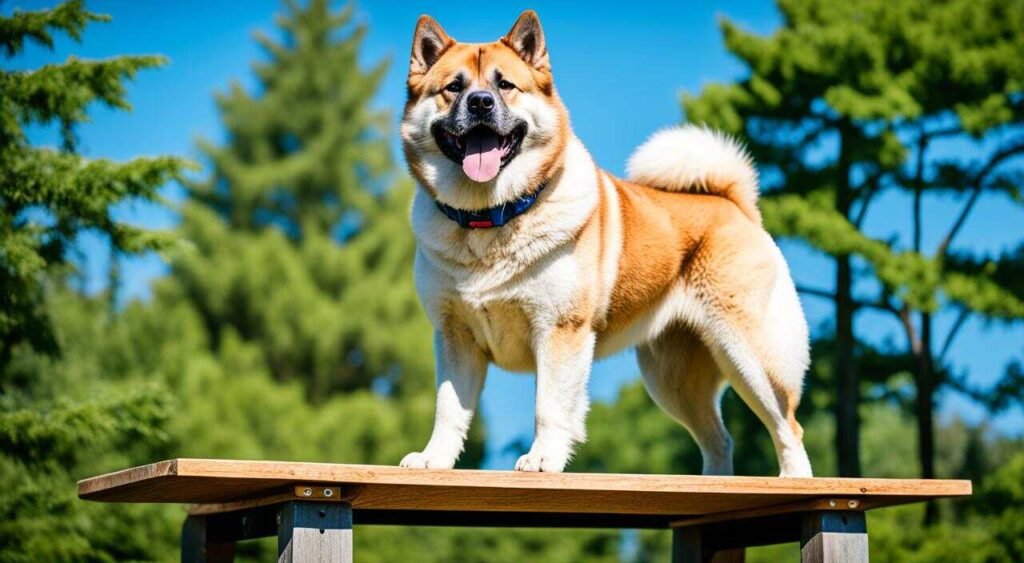The Akita Inu is a breed renowned for its majestic appearance and gentle temperament. With its proud disposition and bear-like face, this large dog is kind, gentle, playful, and eager to find a loving home. Standing at a height of 24-28 inches and weighing between 70-130 lbs, the Akita has a lifespan of 10-14 years.
They come in various colors, including white, brindle, sesame, and red fawn. With their loyalty and reserved nature, Akitas make excellent companions and require proactive training and socialization.
This breed originated in Japan and served as palace guards and hunting dogs. However, they almost faced extinction in the 20th century, but thanks to the efforts of dog enthusiasts, they are now beloved and honored in Japan and around the world.
Akitas are generally healthy dogs but can be predisposed to conditions such as hip dysplasia and hypothyroidism. Grooming requirements include regular brushing and bathing, as well as ear cleaning, nail clipping, and teeth brushing.
The cost of owning an Akita includes expenses for food, grooming, veterinary care, and supplies. Regular exercise, training, and socialization are important for an Akita’s mental and physical well-being.
Key Takeaways:
- Akitas have a majestic appearance and gentle temperament, making them excellent companions.
- They originated in Japan and served as palace guards and hunting dogs.
- Proactive training and socialization are necessary for their well-being.
- Grooming requirements include regular brushing, bathing, and other maintenance tasks.
- Regular exercise, training, and socialization are important for their overall health and happiness.
Origins of the Akita Dog
The Akita dog is an ancient breed that originated in Japan. It served as palace guards and hunting dogs in the 17th century. Akitas were known for their loyalty and devotion to the royal court. They were also skilled in hunting birds, bears, and deer. Akitas were pets of royalty for many years but eventually found their way into the homes of common people. The breed’s popularity grew, and small Akita figurines became common gifts for newborns. American author and activist Helen Keller played a significant role in introducing the Akita to the United States. After World War II, soldiers returning from Japan brought Akitas with them, further spreading their popularity. The Akita breed is now a national monument in Japan and has earned recognition and appreciation worldwide.
Akita Characteristics and Temperament
Akitas are known for their unique characteristics and temperament. They possess a calm and stoic demeanor, exhibiting traits that make them stand out among other dog breeds.
One of the defining characteristics of Akitas is their loyalty. They form deep bonds with their owners and are fiercely protective of their families. This loyalty is one of the reasons why Akitas are often considered as excellent companion dogs.
Akitas are also known for being independent. While they may be reserved with strangers, they are deeply affectionate towards their favorite people. This independence can sometimes make them seem aloof, but it is a natural trait of the breed.
It’s important to note that proper training and socialization from an early age are crucial for Akitas. This helps to ensure that their protective instincts are directed appropriately and that they understand how to behave in different situations.
Akitas have a relatively low tendency to bark compared to other breeds, which makes them suitable for individuals who prefer a quieter pet. However, they are vigilant and will bark to alert their owners if they sense any potential threat.
Additionally, Akitas can be friendly towards other dogs with proper introductions and socialization. It’s important to expose them to different environments, people, and animals to ensure they grow up to be well-rounded and well-behaved dogs.
Overall, Akitas possess a unique combination of loyalty, independence, and protectiveness that sets them apart. With proper care, training, and socialization, they can be loving, devoted, and well-behaved companions.
Akita Care and Health
Proper care and attention are essential for the well-being of an Akita. These majestic dogs require regular grooming, a balanced diet, exercise, and proactive health monitoring. By providing them with the care they need, you can ensure that your Akita remains healthy and happy throughout their life.
Grooming
Grooming plays a crucial role in maintaining the health and appearance of your Akita. Their thick double coat requires regular brushing to prevent matting and to remove loose hair. This not only keeps their coat looking beautiful but also helps to reduce shedding. Bathing should be done as needed, taking care to use a shampoo formulated for dogs to avoid skin irritation.
In addition to brushing and bathing, regular ear cleaning, nail trimming, and teeth brushing are necessary for proper Akita care. Akitas are prone to ear infections, so it’s important to clean their ears regularly to remove excess wax and debris. Trimming their nails helps prevent overgrowth, which can cause discomfort and difficulty walking. Lastly, brushing your Akita’s teeth regularly helps maintain good oral hygiene and prevents dental issues.
Diet
A well-balanced diet is essential for an Akita’s overall health and vitality. Opt for high-quality dog food that provides the right balance of protein, carbohydrates, fats, vitamins, and minerals. Protein sources like chicken, fish, or beef are ideal for Akitas, as they help build and maintain strong muscles. Complex carbohydrates such as sweet potatoes and brown rice provide energy and support digestive health.
“Akitas are generally healthy dogs but can be predisposed to conditions such as hip dysplasia and hypothyroidism.”
Incorporating omega-3 and omega-6 fatty acids into their diet helps support healthy skin and coat. Look for foods enriched with glucosamine and chondroitin, which promote joint health and help prevent conditions like hip dysplasia. It’s essential to provide fresh water at all times to keep your Akita properly hydrated.
Exercise
Akitas have moderate exercise requirements. Daily walks, playtime, and mental stimulation are crucial for their physical and mental well-being. Akitas are a working breed and enjoy activities that challenge their minds and bodies. Engage them in games, obedience training, and puzzle toys to keep them mentally stimulated. This not only fulfills their need for exercise but also helps prevent boredom and destructive behavior.
Common Health Issues
While Akitas are generally healthy dogs, they can be predisposed to certain health issues. Two common conditions seen in Akitas are hip dysplasia and hypothyroidism. Hip dysplasia is a condition where the hip joints are malformed, leading to pain, lameness, and arthritis. Hypothyroidism occurs when the thyroid gland doesn’t produce enough hormones, resulting in weight gain, lethargy, and skin problems.
Veterinary check-ups are crucial for the early detection and management of any health issues. Vaccinations should be kept up to date to protect your Akita from common canine diseases. Your veterinarian can also recommend preventative measures against fleas, ticks, and worms to keep your Akita protected.
In summary, proper Akita care includes regular grooming, a balanced diet, regular exercise, and proactive health monitoring. By providing your Akita with the love and care they deserve, you can ensure they lead a healthy and fulfilling life as your loyal companion.
Training and Socialization for Akitas

Akitas are highly intelligent dogs that respond well to positive reinforcement training methods. By using consistent commands, rewards, and praise, you can establish a strong bond and encourage desired behavior in your Akita. It’s crucial to begin training and socializing your Akita from a young age to ensure they grow up to be obedient and well-rounded dogs.
Socialization is a particularly important aspect of training, as it exposes your Akita to various environments, people, and animals, preventing fear or aggression. By gradually introducing them to new experiences, you can help them develop confidence and appropriate behavior.
Consistency and firm leadership are key to raising a well-behaved Akita. Establish clear boundaries and reinforce them consistently to create a harmonious home environment. Basic obedience commands such as sit, stay, heel, and come should be taught and reinforced through positive reinforcement techniques, such as treats and praise.
Positive Reinforcement Training
Positive reinforcement training is highly effective for Akitas. This approach focuses on rewarding desired behaviors rather than punishing unwanted ones. When your Akita follows a command or exhibits good behavior, reward them with treats, praise, or playtime. This positive association encourages your Akita to repeat the behavior in the future.
“Positive reinforcement training teaches your Akita that good behavior leads to positive outcomes. This approach fosters a strong bond between you and your dog and makes the training process enjoyable for both of you.”
Remember to be patient and consistent with your training efforts. Akitas thrive on routine and clear expectations. Make training sessions short and frequent to maintain their interest and prevent boredom.
Socialization for Akitas
Socialization plays a crucial role in shaping an Akita’s behavior, ensuring they are comfortable and well-behaved in various situations. Introduce your Akita to different people, animals, and environments from an early age. Start with controlled interactions and gradually expose them to new experiences.
“Proper socialization helps your Akita develop into a well-adjusted and confident dog. It reduces the likelihood of fear or aggression towards unfamiliar people, animals, or situations.”
Take your Akita on regular outings to parks, pet-friendly stores, and social gatherings. Encourage positive interactions with other dogs and provide opportunities for them to play and socialize in a controlled environment.
Remember to always prioritize your Akita’s safety and comfort during socialization. Monitor their body language and adjust the intensity of interactions as needed. If your Akita shows signs of fear or unease, provide reassurance and gradually reintroduce them to the situation at a pace that feels comfortable for them.
With the right training techniques and socialization approach, Akitas can become loving, well-behaved companions. Investing time and effort into training and socialization will foster a strong bond with your Akita and contribute to their overall happiness and well-being.
The Akita Inu Husky Mix: Majestic and Captivating
The Akita Husky mix, also known as the Huskita, is a crossbreed that combines the strengths and traits of the Akita and Siberian Husky. These mixes are known for their striking appearance, which can vary from the thick double coat of the Akita to the piercing blue eyes of the Husky. They exhibit a blend of both breeds’ characteristics, including loyalty, playfulness, intelligence, and independence.
Proper training and socialization are crucial for raising a well-adjusted Huskita. These mixed breeds require regular exercise and mental stimulation to keep them physically and mentally healthy. Daily walks, interactive toys, and engaging activities are essential to meet their exercise needs and prevent boredom.
“The Akita Husky mix combines the majestic presence of the Akita and the captivating charm of the Siberian Husky. It’s an appealing blend of beauty, intelligence, and loyalty.”
In terms of temperament, the Akita Husky mix can display a wide range of personalities. Some may have a more dominant nature inherited from the Akita, while others may be more sociable, like the Siberian husky.
Appearance
The appearance of the Akita Husky mix can vary depending on the genetics inherited from each parent. They typically have a strong and muscular build similar to the Akita, with a well-defined muzzle and erect ears. Their coat can be dense and double-layered, often featuring color combinations seen in both breeds.
Training and Exercise
Training and socialization are essential for the Akita Husky mix to develop good behavior and manners. Positive reinforcement methods, such as rewards and praise, work well for these intelligent and eager-to-please dogs. Early training and socialization should start as soon as they join your family to ensure they grow up to be well-behaved and balanced dogs.
Exercise is crucial for the Akita Husky mix to burn off energy and keep them mentally stimulated. Regular exercise routines, including daily walks, playtime, and interactive games, help prevent behavioral issues caused by boredom or pent-up energy.
Conclusion
The Akita Inu is a majestic breed known for its loyal and gentle nature. With their proud appearance and bear-like face, Akitas make excellent companions for families and individuals alike. Their intelligence and loyalty make them a highly sought-after breed, but proper care and attention are essential to ensure their health and well-being.
Regular grooming is necessary to maintain the Akita’s thick double coat, while a high-quality diet and plenty of exercise are vital for their overall health. Training and socialization from an early age are crucial for raising a well-behaved and balanced Akita. With the right care and guidance, Akitas offer a lifetime of companionship and devotion.
Whether you’re considering adopting an Akita or already have one as a furry family member, following these care tips will help ensure a happy and healthy life for your magnificent Akita Inu. Embrace the loyalty, intelligence, and regal nature of this majestic breed, and experience the joy and companionship that an Akita can bring to your life.
FAQ
What is the Akita Inu breed known for?
The Akita Inu is known for its majestic appearance and gentle temperament.
How tall and heavy does an Akita dog typically get?
An Akita can stand at a height of 24-28 inches and weigh between 70-130 lbs.
What colors do Akitas come in?
Akitas come in various colors, including white, brindle, sesame, and red fawn.
What is the origin of the Akita breed?
The Akita originated in Japan and served as palace guards and hunting dogs.
What are some health issues that Akitas may face?
Akitas can be predisposed to conditions such as hip dysplasia and hypothyroidism.
What grooming requirements do Akitas have?
Akitas require regular brushing and bathing, as well as ear cleaning, nail clipping, and teeth brushing.
What is the cost of owning an Akita?
The cost of owning an Akita includes expenses for food, grooming, veterinary care, and supplies.
What kind of training do Akitas require?
Akitas respond well to positive reinforcement training methods and require consistent training and boundaries.
Are Akitas good with other dogs?
Akitas can be friendly towards other dogs with proper introductions and socialization.
What care is necessary for the overall well-being of an Akita?
Proper care includes regular grooming, a high-quality diet, exercise, and regular veterinary check-ups.
What is an Akita Husky mix?
An Akita-Husky mix, also known as a Huskita, is a crossbreed between an Akita and Siberian Husky.








